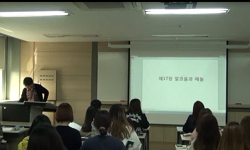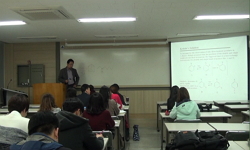방향족화합물들로 오염되어있는 토양 및 산업폐수를 포함한 각종 시료로부터 phenol에 분해활성이 높은 56균주를 순수분리 하였으며, 이들 분리 균주 중 균체생육과 phenol 분해활성이 가장 높...
http://chineseinput.net/에서 pinyin(병음)방식으로 중국어를 변환할 수 있습니다.
변환된 중국어를 복사하여 사용하시면 됩니다.
- 中文 을 입력하시려면 zhongwen을 입력하시고 space를누르시면됩니다.
- 北京 을 입력하시려면 beijing을 입력하시고 space를 누르시면 됩니다.

Phenol 분해균주의 분리 및 페놀함유 폐수의 생물학적 처리 = Isolation of a Phenol-degrading Bacterial Strain and Biological Treatment of Wastewater Containing Phenols
한글로보기https://www.riss.kr/link?id=A101744826
- 저자
- 발행기관
- 학술지명
- 권호사항
-
발행연도
2013
-
작성언어
Korean
- 주제어
-
KDC
470
-
등재정보
KCI등재
-
자료형태
학술저널
- 발행기관 URL
-
수록면
1273-1279(7쪽)
-
KCI 피인용횟수
2
- DOI식별코드
- 제공처
-
0
상세조회 -
0
다운로드
부가정보
국문 초록 (Abstract)
방향족화합물들로 오염되어있는 토양 및 산업폐수를 포함한 각종 시료로부터 phenol에 분해활성이 높은 56균주를 순수분리 하였으며, 이들 분리 균주 중 균체생육과 phenol 분해활성이 가장 높은 균주인 GN13을 선별하였다. 분리균주 GN13은 형태학적, 생리학적 및 생화학적 특성을 조사한 결과 Neisseria 속 세균과 유사한 것으로 판명되어 최종적으로 Neisseria sp. GN13으로 명명하였다. 분리균주 Neisseria sp. GN13의 균체생육 및 phenol 분해를 위한 최적온도와 최적 pH는 각각 32℃와 7.0였다. 유일 탄소원으로 phenol 1,000 mg/l를 포함하여 최적화된 배지를 사용한 jar-fermentor 배지에서 배양 30시간에 균체생육이 최대에 이르렀으며 배양 27시간째 거의 모든 phenol이 분해되었으며, catechol deoxygenase 활성측정에 의하여 Neisseria sp. GN13은 meta-와 ortho-pathway를 통하여 catechol 분해가 일어났다. Neisseria sp. GN13은 phenol 함유 인공폐수에서의 phenol 분해율은 배양 30시간 만에 97%의 phenol이 분해되는 것으로 나타났으며, 인공폐수에 대한 Neisseria sp. GN13과 활성슬러지 처리구에서의 TOC 제거효율은 각각 83%와 78%였다. 석유화학폐수에 대한 Neisseria sp. GN13의 COD 제거율은 활성슬러지만을 포함한 대조구보다 약 1.3배 높은 효율을 나타내었다. 이러한 결과로 미루어 분리균주 Neisseria sp. GN13은 phenol을 함유하고 있는 여러 폐수에 효과적으로 적용될 수 있을 것으로 생각된다.
다국어 초록 (Multilingual Abstract)
Aromatic hydrocarbons, such as phenol, have been detected frequently in wastewater, soil, and groundwater because of the extensive use of oil products. Bacterial strains (56 isolates) that degraded phenol were isolated from soil and industrial wastewa...
Aromatic hydrocarbons, such as phenol, have been detected frequently in wastewater, soil, and groundwater because of the extensive use of oil products. Bacterial strains (56 isolates) that degraded phenol were isolated from soil and industrial wastewater contaminated with hydrocarbons. GN13, which showed the best cell growth and phenol degradation, was selected for further analysis. The GN13 isolate was identified as Neisseria sp. based on the results of morphological, physiological, and biochemical taxonomic analyses and designated as Neisseria sp. GN13. The optimum temperature and pH for phenol removal of Neisseria sp. GN13 was 32°C and 7.0, respectively. The highest cell growth occurred after cultivation for 30 hours in a jar fermentor using optimized medium containing 1,000 mg/l of phenol as the sole carbon source. Phenol was not detected after 27 hours of cultivation. Based on the analysis of catechol dioxygenase, it seemed that catechol was degraded through the meta- and ortho-cleavage pathway. Analysis of the biodegradation of phenol by Neisseria sp. GN13 in artificial wastewater containing phenol showed that the removal rate of phenol was 97% during incubation of 30 hours. The removal rate of total organic carbon (TOC) by Neisseria sp. GN13 and activated sludge was 83% and 78%, respectively. The COD removal rate by Neisseria sp. GN13 from petrochemical wastewater was about 1.3 times higher than that of a control containing only activated sludge.
참고문헌 (Reference)
1 Bitzi, U., "The biodegradation of mixtures of organic solvents by mixed and monocultures of bacteria" 37 : 1037-1042, 1991
2 Hegeman, G. D., "Synthesis of the enzymes of the mandelate pathway by Pseudomonas putida : I. Synthesis of the enzymes by the wild type" 91 : 1140-1154, 1966
3 Gordon, A. H., "Substrate inhibition kinetics ; phenol degradation by Pseudomonas putida" 17 : 1599-1615, 1975
4 APHA, "Standard methods for the examination of water and wastewater" APHA 1992
5 Masque, C., "Selection and adaptation of a phenol-degrading strain of Pseudomonas" 9 : 655-660, 1987
6 Martin, R. W., "Rapid colorimetric estimation of phenol" 21 : 1419-1420, 1949
7 Nordlund, J., "Nucleotide sequence of the meta-clevage pathway enzyme, 2-hydroxymucoic semialdehyde dehydrogenase and, 2-hydroxymuconic semialdehyde hydrolase from Psedomonas CF600" 1049 : 227-320, 1990
8 Shingler, V., "Nucleotide sequence and functional analysis of complete phenol, 3, 4-dimethylphenol catabolic pathway of Pseudomonas sp. strain CF600" 174 : 711-724, 1992
9 Leisinger, T., "Microbial degradation of xenobiotics and recalcitrant compounds" Academic Press 1981
10 Haggblom, M. M., "Microbial breakdown of halogenated aromatic pesticides and related compounds" 103 : 29-72, 1992
1 Bitzi, U., "The biodegradation of mixtures of organic solvents by mixed and monocultures of bacteria" 37 : 1037-1042, 1991
2 Hegeman, G. D., "Synthesis of the enzymes of the mandelate pathway by Pseudomonas putida : I. Synthesis of the enzymes by the wild type" 91 : 1140-1154, 1966
3 Gordon, A. H., "Substrate inhibition kinetics ; phenol degradation by Pseudomonas putida" 17 : 1599-1615, 1975
4 APHA, "Standard methods for the examination of water and wastewater" APHA 1992
5 Masque, C., "Selection and adaptation of a phenol-degrading strain of Pseudomonas" 9 : 655-660, 1987
6 Martin, R. W., "Rapid colorimetric estimation of phenol" 21 : 1419-1420, 1949
7 Nordlund, J., "Nucleotide sequence of the meta-clevage pathway enzyme, 2-hydroxymucoic semialdehyde dehydrogenase and, 2-hydroxymuconic semialdehyde hydrolase from Psedomonas CF600" 1049 : 227-320, 1990
8 Shingler, V., "Nucleotide sequence and functional analysis of complete phenol, 3, 4-dimethylphenol catabolic pathway of Pseudomonas sp. strain CF600" 174 : 711-724, 1992
9 Leisinger, T., "Microbial degradation of xenobiotics and recalcitrant compounds" Academic Press 1981
10 Haggblom, M. M., "Microbial breakdown of halogenated aromatic pesticides and related compounds" 103 : 29-72, 1992
11 Japanese Sewage Works Association, "Methods for Sewage Analysis" Japanese Sewage Works Association 1984
12 Nozaki, M., "Metapyrocatechase (Pseudomanas), Methods in enzymology, 17A" Academic Press 1970
13 Li, J. K., "Kinetics and fluorometric behaviour of a phenol fermentation" 11 : 177-182, 1989
14 Kiyohara, H., "Isolation of Pseudomonas pikettii that degrade, 2, 4, 6-trichlorophenol and their dechlorination of chlrorophenols" 58 : 1276-1283, 1992
15 Lee, C. H., "Isolation and Characterization of a Phenol-Degrading Strain, Acinetobacter sp. GEM2" 22 : 692-699, 1994
16 Ko, Y. H., "Iolation and Characterization of a Naphtalene Degrading Strain, Pseudomonas putida N3" 16 : 199-204, 1988
17 Rand, G. H., "Fundamentals of aquatic toxicology" Hemisphere Publishing Company 1985
18 Sariaslami, F. S., "Development of a combined biological and chemical process for production of industrial aromatics from renewable resources" 61 : 51-69, 2007
19 Tamaoka, K., "Determination of DNA base composition by reversed-phase high-performance liquid chromatography" 25 : 125-128, 1984
20 Apajalahti, J. H. A., "Degradation of polychlorinated phenols by Rhedococcus chlorophenolicus" 25 : 62-67, 1986
21 Hinteregger, C., "Degradation of phenol and phenolic compounds by Pseudomonas putida EKII" 37 : 252-259, 1992
22 Aldrich, T. L., "Cloning and complete nucleotide sequence determination of the cat B gene encoding cis, cis-muconate lactonizing enzyme" 52 : 185-195, 1987
23 MacFaddin, J. F., "Biochemical tests for identification for medical bacteria" Williams & Wilkins Co. 1984
24 Peter, H. A. S., "Bergey's manual of systematic bacteriology" Williams and Wikins Co. 1986
25 Gibson, J. M., "Benzene-free synthesis of phenol" 40 : 1945-1948, 2001
동일학술지(권/호) 다른 논문
-
Genome shuffling을 이용한 에탄올 생산 및 내성 효모 균주의 육종
- 한국생명과학회
- 박아황(A-Hwang Park)
- 2013
- KCI등재
-
- 한국생명과학회
- Sung Hee Park(박성희)
- 2013
- KCI등재
-
항산화 활성을 가진 그래핀이 HT1080 세포에서 기질금속단백질분해효소에 미치는 영향
- 한국생명과학회
- 이수경(Su-Gyeng Lee)
- 2013
- KCI등재
-
Inhibition of Oncogenes Affects the Expression of NKG2D Ligands in Cancer Cells
- 한국생명과학회
- Woong Heo(허웅)
- 2013
- KCI등재
분석정보
인용정보 인용지수 설명보기
학술지 이력
| 연월일 | 이력구분 | 이력상세 | 등재구분 |
|---|---|---|---|
| 2027 | 평가예정 | 재인증평가 신청대상 (재인증) | |
| 2021-01-01 | 평가 | 등재학술지 유지 (재인증) |  |
| 2018-01-01 | 평가 | 등재학술지 유지 (등재유지) |  |
| 2015-01-01 | 평가 | 등재학술지 유지 (등재유지) |  |
| 2011-08-03 | 학술지명변경 | 외국어명 : Korean Journal of Life Science -> Journal of Life Science |  |
| 2011-01-01 | 평가 | 등재학술지 유지 (등재유지) |  |
| 2009-01-01 | 평가 | 등재학술지 유지 (등재유지) |  |
| 2007-01-01 | 평가 | 등재학술지 유지 (등재유지) |  |
| 2004-01-01 | 평가 | 등재학술지 선정 (등재후보2차) |  |
| 2003-01-01 | 평가 | 등재후보 1차 PASS (등재후보1차) |  |
| 2001-07-01 | 평가 | 등재후보학술지 선정 (신규평가) |  |
학술지 인용정보
| 기준연도 | WOS-KCI 통합IF(2년) | KCIF(2년) | KCIF(3년) |
|---|---|---|---|
| 2016 | 0.37 | 0.37 | 0.42 |
| KCIF(4년) | KCIF(5년) | 중심성지수(3년) | 즉시성지수 |
| 0.43 | 0.43 | 0.774 | 0.09 |




 ScienceON
ScienceON DBpia
DBpia



